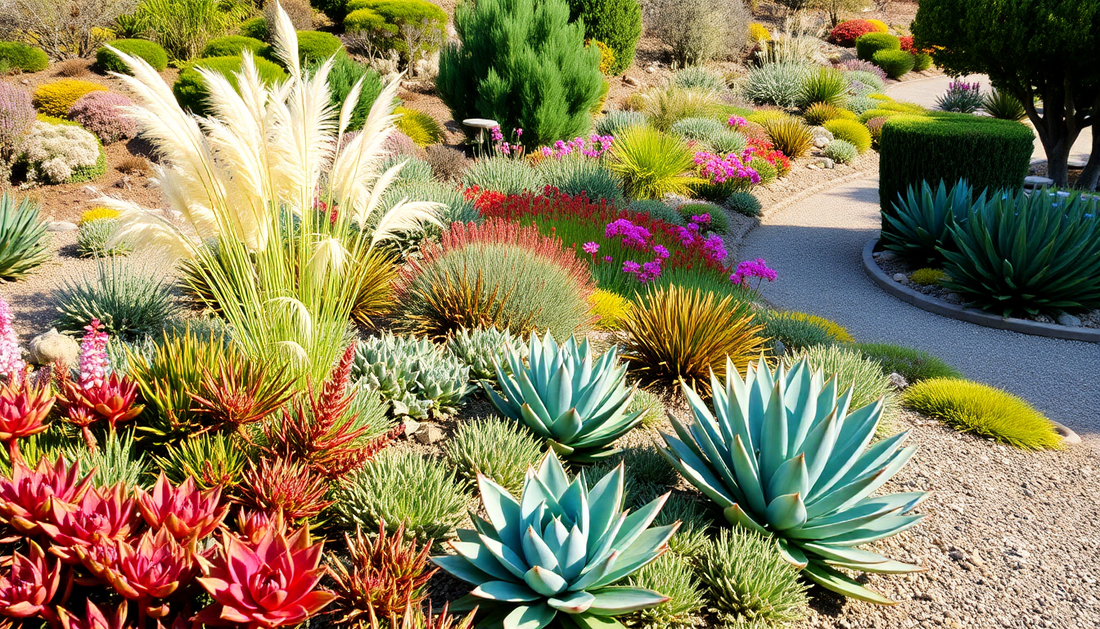
Ornamental Plants for Water Conservation Gardens
Share
Water conservation is an increasingly important concern, especially in regions facing drought and water scarcity. As gardeners, we have the opportunity to make a significant impact by choosing ornamental plants that thrive with minimal water requirements. In this comprehensive guide, we'll explore some of the best drought-tolerant ornamental plants that can help create beautiful, sustainable gardens.
The Importance of Water-Saving Gardening
In many parts of the world, water scarcity is a pressing issue. Climate change, population growth, and unsustainable water usage have all contributed to the depletion of water resources. As responsible gardeners, it's our duty to adopt water-wise practices and select plants that can flourish with limited water input.
Xeriscaping, the practice of designing and maintaining landscapes with drought-tolerant plants, has gained popularity in recent years. By incorporating water-saving ornamental plants into our gardens, we can not only reduce our water consumption but also create visually stunning and environmentally-friendly outdoor spaces.
Characteristics of Drought-Tolerant Ornamental Plants
Drought-tolerant ornamental plants have evolved unique adaptations to thrive in arid and semi-arid environments. These plants often exhibit the following characteristics:
Succulent Foliage
Many drought-tolerant plants have thick, fleshy leaves or stems that store water, allowing them to withstand extended periods of drought. Examples include agave, aloe, and sedum.
Waxy or Hairy Leaves
Some plants have a protective waxy coating or fine hairs on their leaves, which help reduce water loss through transpiration. This includes plants like lavender, artemisia, and sage.
Deep or Extensive Root Systems
Drought-tolerant plants often have deep or extensive root systems that can access water deep in the soil, enabling them to survive dry conditions. Examples include yucca, penstemon, and Russian sage.
Dormancy or Slow Growth
Some drought-tolerant plants enter a state of dormancy or slow growth during dry periods, conserving their resources until conditions improve. This includes plants like ornamental grasses and certain perennials.
Top Drought-Tolerant Ornamental Plants
Now, let's explore some of the best drought-tolerant ornamental plants that can thrive in water-conscious gardens:
Agave
Agave is a genus of succulent plants native to the Americas, known for their striking, architectural rosettes. Agave species like the blue agave (Agave tequilana) and the century plant (Agave americana) are incredibly drought-tolerant and can add a bold, modern touch to any garden.
Lavender
Lavender (Lavandula spp.) is a fragrant, drought-tolerant perennial that thrives in hot, dry conditions. Its silvery-green foliage and purple flower spikes make it a popular choice for Mediterranean-style gardens, rock gardens, and borders.
Yucca
Yucca (Yucca spp.) is a genus of evergreen, succulent-leaved plants that are native to the southwestern United States and Mexico. Yucca plants, such as the Spanish dagger (Yucca aloifolia) and the Joshua tree (Yucca jaegeriana), are known for their striking, architectural forms and can tolerate extended periods of drought.
Sedum
Sedum, also known as stonecrop, is a diverse genus of succulent plants that come in a wide range of shapes, sizes, and colors. Sedums like the autumn stonecrop (Sedum spectabile) and the blue stonecrop (Sedum reflexum) are excellent choices for low-maintenance, drought-tolerant gardens.
Artemisia
Artemisia, or wormwood, is a genus of aromatic, silvery-leaved plants that are highly drought-tolerant. Species like the silver mound (Artemisia schmidtiana) and the silver king (Artemisia ludoviciana) add a soft, textural element to gardens and can thrive in hot, dry conditions.
Penstemon
Penstemon, or beardtongue, is a genus of flowering perennials that are native to North America. Many penstemon species, such as the scarlet bugler (Penstemon centranthifolius) and the Rocky Mountain penstemon (Penstemon strictus), are well-adapted to dry, sunny conditions.
Ornamental Grasses
Ornamental grasses, such as the blue fescue (Festuca glauca) and the purple fountain grass (Pennisetum setaceum), are excellent choices for water-conscious gardens. These grasses often have deep, extensive root systems that allow them to withstand drought conditions.
Designing a Water-Saving Garden
When creating a water-conscious garden, it's important to consider the overall design and placement of your drought-tolerant ornamental plants. Here are some tips to help you get started:
Group Plants with Similar Water Needs
Arrange your plants in zones based on their water requirements. Group together plants that have similar drought tolerance, allowing you to water them efficiently and effectively.
Incorporate Mulch
Apply a 2-4 inch layer of organic mulch, such as wood chips or shredded bark, around your plants. This helps retain soil moisture and suppress weed growth, reducing the need for frequent watering.
Utilize Drip Irrigation
Consider installing a drip irrigation system, which delivers water directly to the root zone of your plants, minimizing water waste and evaporation.
Embrace Xeriscape Design
Incorporate xeriscape design principles, such as using gravel, rocks, and drought-tolerant groundcovers, to create visually appealing and low-maintenance gardens.
Prioritize Native Plants
Whenever possible, choose native drought-tolerant plants that are well-adapted to your local climate and soil conditions. These plants will thrive with minimal water input.
By incorporating these water-saving strategies and selecting the right drought-tolerant ornamental plants, you can create a beautiful, sustainable garden that not only conserves precious water resources but also adds visual interest and texture to your outdoor space.
Conclusion
In a world where water conservation is increasingly crucial, the choice of ornamental plants for our gardens can make a significant impact. By embracing drought-tolerant species, we can create stunning, low-maintenance landscapes that thrive with minimal water input. From the architectural beauty of agave to the fragrant allure of lavender, the options for water-saving ornamental plants are vast and diverse. By following the principles of xeriscape design and prioritizing native species, we can cultivate gardens that are not only visually captivating but also environmentally responsible. Join us in this journey towards water-conscious gardening and help shape a more sustainable future for our communities.
